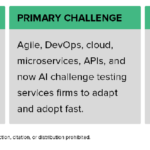There’s a lot to be excited about when it comes to the technology market in 2024 — whether due to the rapid rise of the Asia Pacific market, huge demand for software, the wide-ranging possibilities of generative AI, and/or a growing need for green and digital innovation. In addition, economic conditions will improve this year due to lower energy prices, healing supply chains, and declining inflation. Cautious optimism abounds: Forrester is forecasting that global tech spend will reach $4.7 trillion in 2024, growing 5.3% in 2024 — a significant improvement on 2023’s 3.5%.
Asia Pacific Will Lead Growth, Increasing Tech Spend By 5.7%
According to the IMF’s World Economic Outlook, Asia Pacific will lead growth. Among major economies, the six forecasted to have the largest real GDP growth in 2024 will be from that region: India, the Philippines, Vietnam, Indonesia, Malaysia, and China. Comparing the three regions:
- Asia Pacific will grow 5.7%. Leading the way is India, which is one of the largest exporters of technology services and will see a fast 9.5% growth of domestic and government tech spend in 2024. In China, the digital economy is estimated to account for 41.5% of GDP. In Japan, however, 60% of Japanese small- to medium-sized enterprises have not started business digitalization, and 80% of digital investment is used for maintenance and operations.
- North America will grow 5.4%. Financial services and healthcare will have the fastest tech spend growth in 2024. Software and IT services will capture 60% of US tech spend by 2027, up from 53% in 2018. The US government is allocating $25 billion to emerging technologies in 2024 through the development of three primary CHIPS and Science Act agencies.
- Europe will grow 5.1%. Europe will bounce back from a tough 2023, when spend grew only 2.6%. Europe needs to further accelerate tech spend growth to reach digital technology enterprise targets. If current trends continue, only 66% of businesses will use cloud, 34% big data, and 20% AI, far from the 75% objective set for 2030.
Software, Generative AI, And Green And Digital Innovation Are 2024 Focuses
In 2024, Forrester suggests that companies invest in technology that backs their long-term growth. Among their focuses should be software, generative AI, and green and digital innovation, which will let companies be more adaptive and resilient by streamlining operations, providing the platform for future growth, and reducing enterprise risk. Let’s look at those three focus areas in greater detail:
- Software. Custom and off-the-shelf software revenues will see double-digit growth. Cloud service demand is strong. In fiscal year 2023, Microsoft’s annual cloud revenues grew 27%, while Google Cloud’s revenues grew 26% in the first nine months of 2023. Investments in generative AI software are forecasted to grow 36% annually between 2023 and 2030, reaching $227 billion.
- Generative AI. Large consulting firms are pivoting their offerings to AI to develop a solutions delivery track record, a key attribute of customer obsession. Over the next three years, Capgemini plans to invest $2 billion in generative AI, with PwC and Cognizant each investing $1 billion. Generative AI companies are partnering with hyperscalers to access computing power: OpenAI with Microsoft, Anthropic and Stability AI with Amazon, and Cohere with Oracle.
- Green and digital innovation. Governments are under pressure to control data-center energy growth, which, left unchecked, could account for 4% of global electricity consumption. Europe’s Climate Neutral Data Centre Pact, for example, pledges to make data centers carbon-neutral by 2030. Innovative companies see faster revenue growth, and firms with higher digital technology investment also see faster productivity growth.
To learn more about the tech investments that companies are making — and the tech investments that they should make — to cover $4.7 trillion of spend this year, read Forrester’s new report, Global Tech Market Forecast, 2023 To 2027. And if you haven’t already, check out Forrester’s forecasts focused specifically on European and US tech spend.








